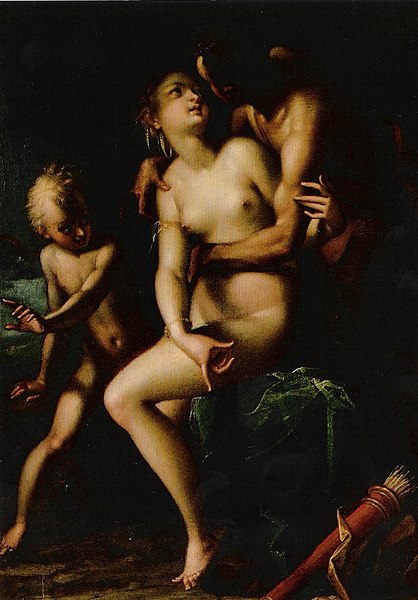In the rich tapestry of Greek mythology, the tale of Antiope, the Amazonian princess, unfolds with a blend of adventure, romance, and the eternal struggle between duty and desire. Her narrative is not just a solitary saga, but a thread intricately woven into the larger narrative of the Trojan War, intersecting with the lives of notable heroes like Menelaus and Agamemnon.
Antiope Key Facts
| Parents | Ares and Otrera |
| Partners | Theseus (might be a mix-up between her and Hippolyta) |
| Siblings | Hippolyta, Melanippe, and Penthesilea |
| Offspring | Hippolytus (several sources have Hippolyta as his mother) |
| Other names | None known |
| Roman name | Antiope |
| Best Known Myth | Abduction by Theseus |
Name and Etymology
The name Antiope holds a resonance that echoes the fierce and indomitable spirit of the Amazons. Derived from the ancient Greek, it’s a name that can be dissected into ‘anti,’ meaning against, and ‘ops,’ meaning face or eye. It’s a moniker that suggests confrontation, a facing down of foes, a characteristic well embodied in the Amazonian ethos.
In the Roman rendition, her name remains unchanged, a testament perhaps to the enduring allure and respect accorded to her persona. The Romans, like the Greeks, were enamored by the tales of valor and virtue that surrounded the Amazons, and Antiope was a prominent figure within these narratives.
Her epithets are scarce, but each one is a tribute to her valor and her heritage. They are not mere appellations, but a narrative, a glimpse into the life and the world of a princess, a warrior, and a lover.

Antiope Family and Relationships
Born to Ares, the god of war, and Otrera, the queen of the Amazons, Antiope was destined for a life less ordinary. Her lineage was not just noble, but divine, a heritage she shared with her sisters Hippolyta, Melanippe, and Penthesilea. The realm of the Amazons was her playground, and the art of war her playmate.
Her birth was not marked by celestial omens or prophecies, yet it was significant. It was a birth that heralded the arrival of a warrior, a leader, and a heroine whose tale would be sung by bards and chronicled by scholars.
Antiope’s heart was claimed by Theseus, the king of Athens, a love that was as passionate as it was tumultuous. Their union was marked by love and strife, a reflection of the turbulent times they lived in.
Depiction And Characteristics
Antiope’s persona is a blend of feminine grace and warrior-like ferocity, a juxtaposition that reflects the dual nature of her heritage. Her appearance, as depicted in ancient art, often showcases a woman of striking beauty, with an athletic build honed by years of training in the art of war. Her attire, typically, is a blend of Amazonian and Athenian styles, a visual narrative of her life’s journey.
The symbols associated with Antiope are often those of war and love. The sword, the shield, and the bow are her companions, emblematic of her warrior heritage. Yet, intertwined with these symbols of war, one often finds symbols of love and maternity, a reflection of her journey from a warrior princess to a loving partner and mother.
Antiope’s personality, as gleaned from the myths, is a blend of courage, loyalty, and a fierce love for her family. Her actions, whether on the battlefield or in the heart of Athens, are driven by a sense of duty and a deep love for her kin.
The flora and fauna associated with Antiope are often those native to her homeland. The olive tree, a symbol of peace and prosperity in ancient Greece, and the eagle, a symbol of strength and freedom, are often associated with her, embodying the dual aspects of her persona – the warrior and the peacemaker.
Myths about Antiope
Antiope’s tale is a blend of romance and conflict, a narrative that mirrors the era she lived in. Her myths not only reflect her personal journey but also the broader socio-political dynamics of the time.
Abduction by Theseus
The saga of Antiope and Theseus began with an abduction, a common motif in Greek mythology, symbolizing the clash and melding of different cultures. Theseus, smitten by her beauty and valor, took her to Athens. It was a beginning marked by conflict, yet it blossomed into a love that was deep and enduring. Their union, though born out of strife, was a testament to the power of love, a force capable of bridging the chasm between two disparate worlds.
Their love was not a tranquil river, but a tempestuous sea, mirroring the tumult of the era. It was a love forged in the crucible of conflict, tested by trials and tribulations, yet it endured, a beacon of hope in a time of despair.
The abduction, though a violent beginning, was also a union of two worlds, a melding of cultures and ideologies. It was a narrative that showcased the power of love to transcend barriers, to heal wounds, and to forge alliances.
The Amazonomachy
Another significant myth involving Antiope is the Amazonomachy, the epic battle between the Athenians and the Amazons. This battle was said to have been triggered by Antiope’s abduction by Theseus. The Amazons, led by Antiope’s sisters, marched to Athens to rescue her, resulting in a fierce battle.
The Amazonomachy is often depicted in ancient art and literature as a clash of civilizations, symbolizing the tension between the patriarchal Greek society and the matriarchal Amazonian society. Antiope found herself torn between her love for Theseus and her loyalty to her Amazonian kin, embodying the personal and political dilemmas that come with love and war.
This myth also highlights the valor and prowess of the Amazons, showcasing a society where women were revered for their strength and courage.
Birth of Hippolytus
The birth of Hippolytus, the son of Antiope and Theseus, is another notable myth. Hippolytus’ birth was a symbol of the union between Athens and the Amazons, a hope for a peaceful coexistence between two contrasting civilizations.
However, Hippolytus’ life was marked by tragedy and conflict, reflecting the turbulent times he was born into. His disdain for the goddess Aphrodite and his subsequent curse is a narrative that explores the themes of love, honor, and the divine whims that often played a pivotal role in the lives of Greek heroes and heroines.
Fluidity of Sources and the Tale of Abduction
The tale of Theseus’ abduction of an Amazonian is a captivating narrative that serves as a precursor to the epic battle known as the Amazonomachy. However, the identity of the abducted princess varies across different sources, reflecting the fluidity and the nuanced nature of ancient storytelling.
Most ancient texts and subsequent interpretations lean towards Hippolyta, the Amazonian queen, as the one who was abducted by Theseus. This act of abduction is often cited as the catalyst for the Amazonomachy, the grand confrontation between the Athenians and the Amazons. The narrative goes on to depict a fierce battle, with the Amazons, led by Antiope and her sisters, marching to Athens to rescue Hippolyta, showcasing a tale of loyalty, valor, and the clash of civilizations.
On the other hand, a fewer number of sources mention Antiope as the abducted Amazon, weaving a slightly different narrative but with similar overarching themes. The variation in the name of who was abducted across different sources could be attributed to the oral tradition of storytelling, where details could have morphed over time before being chronicled in text. Additionally, the close-knit nature of the Amazonian society and the intertwined familial relationships could have contributed to the confusion between the two sisters.
The fluidity of sources and the variation in names highlight the complex and sometimes convoluted nature of Greek mythology. The tale of Theseus and the Amazonian abductee, whether it be Antiope or Hippolyta, showcases a rich narrative that delves into the themes of love, loyalty, and the eternal struggle between duty and desire. This ambiguity not only adds a layer of intrigue to the narrative but also opens up avenues for deeper exploration and interpretation of the ancient texts, allowing for a richer understanding of the multifaceted world of Greek mythology.
Representations Of Antiope In Art
Antiope’s tale has inspired many a painter and sculptor over the centuries. Her depiction in art is a visual narrative, a blend of her Amazonian heritage and her Athenian saga. The portrayal often captures the essence of a woman who was both a warrior and a lover.
One of the notable pieces of art is a sculpture showcasing her alongside Theseus, a visual narrative of love amidst the backdrop of war. Their expressions, a blend of love, longing, and a shared destiny, encapsulate the essence of their tale.
Her portrayal in art is not just a tribute to her persona, but a glimpse into the era she lived in. Through the strokes of the brush and the chisel of the sculptor, one can glean the ethos of an era marked by love, war, and the eternal quest for honor and glory.

Mentions in Ancient Texts
Antiope’s narrative, while not as extensively chronicled as some of her contemporaries, finds its way into several ancient texts, each shedding light on different facets of her life and adventures.
Plutarch’s “Life of Theseus”
Plutarch, a Greek biographer and essayist of the 1st century AD, delves into the saga of Antiope and Theseus in his work “Life of Theseus.” This narrative provides a glimpse into their tumultuous yet passionate relationship. A notable excerpt encapsulates the essence of their union, stating, “In love, as in war, victory lay with the bold.”
Ovid’s “Heroides”
Ovid, a significant Roman poet who lived during the reign of Augustus, touches upon the tale of Antiope, albeit briefly, in his poetic epistles titled “Heroides,” written in the 1st century BC. It’s a narrative that showcases the eternal struggle between duty and desire. A poignant quote reflects the essence of her tale, stating, “Love conquers all; let us too yield to love.”
Hyginus’ “Fabulae”
Gaius Julius Hyginus, a Latin author of the 1st century BC, mentions Antiope in his collection of myths titled “Fabulae.” Though his work is more of a compilation than original narrative, it serves as a valuable repository of mythological tales, including that of Antiope. His narrative touches on her abduction by Theseus and the subsequent events that unfolded.
Pausanias’ “Description of Greece”
Pausanias, a Greek traveler and geographer of the 2nd century AD, in his work “Description of Greece,” mentions Antiope while describing the various historical and mythological landmarks of Greece. His narrative provides a geographical context to the tale of Antiope, grounding her story in the real-world locales of ancient Greece.
Frequently Asked Questions
Antiope is renowned as an Amazonian princess who was abducted by Theseus, with whom she later had a son, Hippolytus. Her tale is intricately linked with the larger narrative of the Trojan War.
She was born to Ares, the god of war, and Otrera, the queen of the Amazons.
Yes, she had three sisters: Hippolyta, Melanippe, and Penthesilea, all significant figures in Amazonian lore.
Her heart was won by Theseus, the king of Athens, with whom she bore a son, Hippolytus.
Her narrative intersects with the Trojan War through her interactions with figures like Menelaus and Agamemnon, showcasing the interconnectedness of Greek mythology.
Symbols of war such as the sword, shield, and bow, along with symbols of love and maternity, are often associated with Antiope, reflecting her dual persona as a warrior and a lover.
Featured Image Credit: Hendrik Goltzius, Public domain, via Wikimedia Commons
